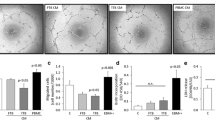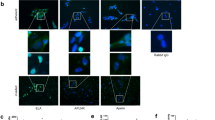Abstract
Endocrine gland-derived vascular endothelial growth factor (EG-VEGF) is an angiogenic factor reported to be specific for endocrine tissues, including the placenta. Its biological activity is mediated via two G protein-coupled receptors, prokineticin receptor 1 (PROKR1) and prokineticin receptor 2 (PROKR2). We have recently shown that (i) EG-VEGF expression peaks between the 8th and 11th weeks of gestation, (ii) its mRNA and protein levels are up-regulated by hypoxia, (iii) EG-VEGF is a negative regulator of trophoblast invasion and (iv) its circulating levels are increased in preeclampsia (PE), the most threatening pathology of pregnancy. Here, we investigated the regulation of the expression of EG-VEGF and its receptors by hCG, a key pregnancy hormone that is also deregulated in PE. During the first trimester of pregnancy, hCG and EG-VEGF exhibit the same pattern of expression, suggesting that EG-VEGF is potentially regulated by hCG. Both placental explants (PEX) and primary cultures of trophoblasts from the first trimester of pregnancy were used to investigate this hypothesis. Our results show that (i) LHCGR, the hCG receptor, is expressed both in cyto- and syncytiotrophoblasts, (ii) hCG increases EG-VEGF, PROKR1 and PROKR2 mRNA and protein expression in a dose- and time-dependent manner, (iii) hCG increases the release of EG-VEGF from PEX conditioned media, (iv) hCG effects are transcriptional and post-transcriptional and (v) the hCG effects are mediated by cAMP via cAMP response elements present in the EG-VEGF promoter region. Altogether, these results demonstrate a new role for hCG in the regulation of EG-VEGF and its receptors, an emerging regulatory system in placental development.








Similar content being viewed by others
References
Fitzgerald B, Levytska K, Kingdom J, Walker M, Baczyk D, Keating S (2011) Villous trophoblast abnormalities in extremely preterm deliveries with elevated second trimester maternal serum hCG or inhibin-A. Placenta 32:339–345
Brouillet S, Hoffmann P, Benharouga M, Salomon A, Schaal JP, Feige JJ, Alfaidy N (2010) Molecular characterization of EG-VEGF-mediated angiogenesis: differential effects on microvascular and macrovascular endothelial cells. Mol Biol Cell 21:2832–2843
Hoffmann P, Saoudi Y, Benharouga M, Graham CH, Schaal JP, Mazouni C, Feige JJ, Alfaidy N (2009) Role of EG-VEGF in human placentation: Physiological and pathological implications. J Cell Mol Med 13:2224–2235
LeCouter J, Kowalski J, Foster J, Hass P, Zhang Z, Dillard-Telm L, Frantz G, Rangell L, DeGuzman L, Keller GA, Peale F, Gurney A, Hillan KJ, Ferrara N (2001) Identification of an angiogenic mitogen selective for endocrine gland endothelium. Nature 412:877–884
Battersby S, Critchley HO, Morgan K, Millar RP, Jabbour HN (2004) Expression and regulation of the prokineticins (endocrine gland-derived vascular endothelial growth factor and Bv8) and their receptors in the human endometrium across the menstrual cycle. J Clinical Endocrinol Metabolism 89:2463–2469
Ferrara N, Frantz G, LeCouter J, Dillard-Telm L, Pham T, Draksharapu A, Giordano T, Peale F (2003) Differential expression of the angiogenic factor genes vascular endothelial growth factor (VEGF) and endocrine gland-derived VEGF in normal and polycystic human ovaries. Am J Pathol 162:1881–1893
LeCouter J, Zlot C, Tejada M, Peale F, Ferrara N (2004) Bv8 and endocrine gland-derived vascular endothelial growth factor stimulate hematopoiesis and hematopoietic cell mobilization. Proc Natl Acad Sci USA 101:16813–16818
Podlovni H, Ovadia O, Kisliouk T, Klipper E, Zhou QY, Friedman A, Alfaidy N, Meidan R (2006) Differential expression of prokineticin receptors by endothelial cells derived from different vascular beds: a physiological basis for distinct endothelial function. Cell Physiol Biochem 18:315–326
Samson M, Peale FV Jr, Frantz G, Rioux-Leclercq N, Rajpert-De Meyts E, Ferrara N (2004) Human endocrine gland-derived vascular endothelial growth factor: expression early in development and in Leydig cell tumors suggests roles in normal and pathological testis angiogenesis. J Clinical Endocrinol Metabolism 89:4078–4088
Lin DC, Bullock CM, Ehlert FJ, Chen JL, Tian H, Zhou QY (2002) Identification and molecular characterization of two closely related G protein-coupled receptors activated by prokineticins/endocrine gland vascular endothelial growth factor. J Biological Chem 277:19276–19280
Hoffmann P, Feige JJ, Alfaidy N (2006) Expression and oxygen regulation of endocrine gland-derived vascular endothelial growth factor/prokineticin-1 and its receptors in human placenta during early pregnancy. Endocrinology 147:1675–1684
Hoffmann P, Feige JJ, Alfaidy N (2007) Placental expression of EG-VEGF and its receptors PKR1 (prokineticin receptor-1) and PKR2 throughout mouse gestation. Placenta 28:1049–1058
Herr F, Baal N, Reisinger K, Lorenz A, McKinnon T, Preissner KT, Zygmunt M (2007) HCG in the regulation of placental angiogenesis. Results of an in vitro study. Placenta 28(Suppl A):S85–S93
Licht P, Russu V, Wildt L (2001) On the role of human chorionic gonadotropin (hCG) in the embryo-endometrial microenvironment: implications for differentiation and implantation. Semin Reprod Med 19:37–47
Malassine A, Cronier L (2002) Hormones and human trophoblast differentiation: a review. Endocrine 19:3–11
Licht P, Fluhr H, Neuwinger J, Wallwiener D, Wildt L (2007) Is human chorionic gonadotropin directly involved in the regulation of human implantation? Mol Cell Endocrinol 269:85–92
Zygmunt M, Herr F, Keller-Schoenwetter S, Kunzi-Rapp K, Munstedt K, Rao CV, Lang U, Preissner KT (2002) Characterization of human chorionic gonadotropin as a novel angiogenic factor. J Clinical Endocrinol Metabolism 87:5290–5296
Rao CV, Lei ZM (2007) The past, present and future of nongonadal LH/hCG actions in reproductive biology and medicine. Mol Cell Endocrinol 269:2–8
Shi QJ, Lei ZM, Rao CV, Lin J (1993) Novel role of human chorionic gonadotropin in differentiation of human cytotrophoblasts. Endocrinology 132:1387–1395
Yoshida Y (2005) Secretion of human chorionic gonadotropin in early pregnancy. Med Mol Morphol 38:104–111
Frendo JL, Olivier D, Cheynet V, Blond JL, Bouton O, Vidaud M, Rabreau M, Evain-Brion D, Mallet F (2003) Direct involvement of HERV-W Env glycoprotein in human trophoblast cell fusion and differentiation. Mol Cell Biol 23:3566–3574
Ryu KS, Gilchrist RL, Koo YB, Ji I, Ji TH (1998) Gene, interaction, signal generation, signal divergence and signal transduction of the LH/CG receptor. Int J Gynaecology and obstetrics: the off organ of the Int Federation of Gynaecology and Obstetrics 60(Suppl 1):S9–S20
Ryu KS, Ji I, Chang L, Ji TH (1996) Molecular mechanism of LH/CG receptor activation. Mol Cell Endocrinol 125:93–100
Alsat E, Cedard L (1974) Demonstration of a specific fixation of radio-iodinated human chorionic gonadotropin (HCG I-125) in fragments of human placentas. C R Acad Sci Hebd Seances Acad Sci D 278:2665–2668
Reshef E, Lei ZM, Rao CV, Pridham DD, Chegini N, Luborsky JL (1990) The presence of gonadotropin receptors in nonpregnant human uterus, human placenta, fetal membranes, and decidua. J Clinical Endocrinol Metabolism 70:421–430
Jauniaux E, Bao S, Eblen A, Li X, Lei ZM, Meuris S, Rao CV (2000) HCG concentration and receptor gene expression in placental tissue from trisomy 18 and 21. Mol Hum Reprod 6:5–10
Licht P, Cao H, Lei ZM, Rao CV, Merz WE (1993) Novel self-regulation of human chorionic gonadotropin biosynthesis in term pregnancy human placenta. Endocrinology 133:3014–3025
Pidoux G, Gerbaud P, Tsatsaris V, Marpeau O, Ferreira F, Meduri G, Guibourdenche J, Badet J, Evain-Brion D, Frendo JL (2007) Biochemical characterization and modulation of LH/CG-receptor during human trophoblast differentiation. J Cell Physiol 212:26–35
Rao CV (1996) The beginning of a new era in reproductive biology and medicine : Expression of low functional luteinizing hormone/human chorionic gonadotropin receptors in nongonadal tissues. J Physiol Pharmacol 47:41–53
Botelho LH, Webster LC, Rothermel JD, Baraniak J, Stec WJ (1988) Inhibition of cAMP-dependent protein kinase by adenosine cyclic 3′-, 5′-phosphorodithioate, a second cAMP antagonist. J Biological Chem 263:5301–5305
Alfaidy N, Gupta S, DeMarco C, Caniggia I, Challis JR (2002) Oxygen regulation of placental 11 beta-hydroxysteroid dehydrogenase 2: physiological and pathological implications. J Clinical Endocrinol Metabolism 87:4797–4805
Bradbury FA, Menon KM (1999) Evidence that constitutively active luteinizing hormone/human chorionic gonadotropin receptors are rapidly internalized. Biochemistry 38:8703–8712
Menon KM, Menon B, Wang L, Gulappa T, Harada M (2010) Molecular regulation of gonadotropin receptor expression: relationship to sterol metabolism. Mol Cell Endocrinol 329:26–32
Menon KM, Munshi UM, Clouser CL, Nair AK (2004) Regulation of luteinizing hormone/human chorionic gonadotropin receptor expression: a perspective. Biol Reprod 70:861–866
Conti M, Harwood JP, Hsueh AJ, Dufau ML, Catt KJ (1976) Gonadotropin-induced loss of hormone receptors and desensitization of adenylate cyclase in the ovary. J Biological Chem 251:7729–7731
Kisliouk T, Levy N, Hurwitz A, Meidan R (2003) Presence and regulation of endocrine gland vascular endothelial growth factor/prokineticin-1 and its receptors in ovarian cells. J Clinical Endocrinol Metabolism 88:3700–3707
Kisliouk T, Podlovni H, Meidan R (2005) Unique expression and regulatory mechanisms of EG-VEGF/prokineticin-1 and its receptors in the corpus luteum. Ann Anat 187:529–537
Kisliouk T, Podlovni H, Spanel-Borowski K, Ovadia O, Zhou QY, Meidan R (2005) Prokineticins (endocrine gland-derived vascular endothelial growth factor and BV8) in the bovine ovary: expression and role as mitogens and survival factors for corpus luteum-derived endothelial cells. Endocrinology 146:3950–3958
Evans J, Catalano RD, Brown P, Sherwin R, Critchley HO, Fazleabas AT, Jabbour HN (2009) Prokineticin 1 mediates fetal-maternal dialogue regulating endometrial leukemia inhibitory factor. FASEB J 23:2165–2175
Evans J, Catalano RD, Morgan K, Critchley HO, Millar RP, Jabbour HN (2008) Prokineticin 1 signaling and gene regulation in early human pregnancy. Endocrinology 149:2877–2887
Catalano RD, Lannagan TR, Gorowiec M, Denison FC, Norman JE, Jabbour HN (2010) Prokineticins: novel mediators of inflammatory and contractile pathways at parturition? Mol Hum Reprod 16:311–319
Denison FC, Battersby S, King AE, Szuber M, Jabbour HN (2008) Prokineticin-1: a novel mediator of the inflammatory response in third-trimester human placenta. Endocrinology 149:3470–3477
Islami D, Bischof P, Chardonnens D (2003) Modulation of placental vascular endothelial growth factor by leptin and hCG. Mol Hum Reprod 9:395–398
Menon KM, Nair AK, Wang L (2006) A novel post-transcriptional mechanism of regulation of luteinizing hormone receptor expression by an RNA binding protein from the ovary. Mol Cell Endocrinol 246:135–141
Bukovsky A, Indrapichate K, Fujiwara H, Cekanova M, Ayala ME, Dominguez R, Caudle MR, Wimalsena J, Elder RF, Copas P, Foster JS, Fernando RI, Henley DC, Upadhyaya NB (2003) Multiple luteinizing hormone receptor (LHR) protein variants, interspecies reactivity of anti-LHR mAb clone 3B5, subcellular localization of LHR in human placenta, pelvic floor and brain, and possible role for LHR in the development of abnormal pregnancy, pelvic floor disorders and Alzheimer’s disease. Reprod Biol Endocrinol 1:46
Misrahi M, Beau I, Ghinea N, Vannier B, Loosfelt H, Meduri G, Vu Hai MT, Milgrom E (1996) The LH/CG and FSH receptors: different molecular forms and intracellular traffic. Mol Cell Endocrinol 125:161–167
Pidoux G, Gerbaud P, Marpeau O, Guibourdenche J, Ferreira F, Badet J, Evain-Brion D, Frendo JL (2007) Human placental development is impaired by abnormal human chorionic gonadotropin signaling in trisomy 21 pregnancies. Endocrinology 148:5403–5413
Aplin JD (2010) Developmental cell biology of human villous trophoblast: current research problems. Int J Developmental Biol 54:323–329
Chan CC, Lao TT, Cheung AN (1999) Apoptotic and proliferative activities in first trimester placentae. Placenta 20:223–227
Kar M, Ghosh D, Sengupta J (2007) Histochemical and morphological examination of proliferation and apoptosis in human first trimester villous trophoblast. Hum Reproduction (Oxf, Engl) 22:2814–2823
Knofler M, Saleh L, Bauer S, Vasicek R, Griesinger G, Strohmer H, Helmer H, Husslein P (2000) Promoter elements and transcription factors involved in differentiation-dependent human chorionic gonadotrophin-alpha messenger ribonucleic acid expression of term villous trophoblasts. Endocrinology 141:3737–3748
Gaspard U, Foidart JM, Lambotte R, Reuter AM, Franchimont P (1984) Human chorionic gonadotropin and its subunits in normal and pathologic pregnancies. Ann Endocrinol 45:269–280
Goldstein DP, Berkowitz RS (1994) Current management of complete and partial molar pregnancy. J Reproduct Med 39:139–146
Myatt L, Miodovnik M (1999) Prediction of preeclampsia. Semin Perinatol 23:45–57
Acknowledgments
We thank the staff of the Department of Gynecology/Obstetrics (Pr. J.P. Schaal) at the University Hospital of Grenoble for giving us access to human placentas. We acknowledge the following sources of funding: INSERM (U1036), University Joseph Fourier, Commissariat à l’Energie Atomique (DSV/iRTSV/BCI), the Région Rhône-Alpes (CIBLE-2008). S.B. was supported by doctoral scholarships from the French Ministry of Education and Research and from the Fondation pour la Recherche Médicale.
Author information
Authors and Affiliations
Corresponding author
Rights and permissions
About this article
Cite this article
Brouillet, S., Hoffmann, P., Chauvet, S. et al. Revisiting the role of hCG: new regulation of the angiogenic factor EG-VEGF and its receptors. Cell. Mol. Life Sci. 69, 1537–1550 (2012). https://doi.org/10.1007/s00018-011-0889-x
Received:
Revised:
Accepted:
Published:
Issue Date:
DOI: https://doi.org/10.1007/s00018-011-0889-x




